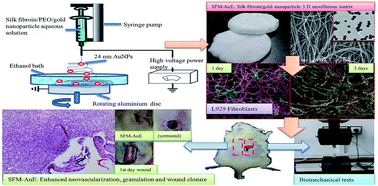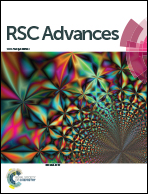Wet electrospun silk fibroin/gold nanoparticle 3D matrices for wound healing applications†
Abstract
This study aimed to fabricate 3D silk fibroin (SF) matrices for skin tissue engineering applications. SF/poly(ethylene oxide) solutions were wet electrospun to obtain a fibrous network (0.7–20 μm diameter), which were then lyophilized to obtain 3D porous nanofibrous matrices (SFM-E: ethanol treated silk fibroin matrices). SF matrices were loaded with citrate-capped gold nanoparticles (AuNPs, 14.27 ppm, Daverage = 24 nm) (SFM-AuE: ethanol treated silk fibroin matrices incorporated with AuNPs) and investigated for structural and chemical properties, in vitro biocompatibility and in vivo full-thickness dermal wound healing efficacy in a rat model. AuNP incorporation enhanced the degradation profiles and mechanical properties significantly. SFM-E and SFM-AuE showed similar cell attachment and layer by layer proliferation behaviour, but cells had more spread and flattened morphology on SFM-AuE. Both matrix extracts had high cell viability (>90%), indicating good in vitro biocompatibility. Wound closure was statistically more than the untreated skin control (UTSC) in SFM-E and SFM-AuE applied groups. The recovered tensile strength and elastic modulus of SFM-E and SFM-AuE (40–60%) were not as high as the unwounded skin control (UWSC), but they had elongation at break values similar to UWSC. This was attributed to the still ongoing medium to high inflammation levels leading to a low and immature extent of collagen fibrils on postoperative 14th day. There was only a small amount of epithelialization due to scab formation and medium to high level inflammation for both SFM-E and SFM-AuE, but they were better than UTSC in terms of neovascularization and granulation tissue formation. As a whole, inclusion of AuNPs to SF matrices at 14.27 ppm loading brought some enhancement in the matrix properties and did not cause any toxicity in in vitro and in vivo conditions and even had potency to promote wound healing stages.


 Please wait while we load your content...
Please wait while we load your content...